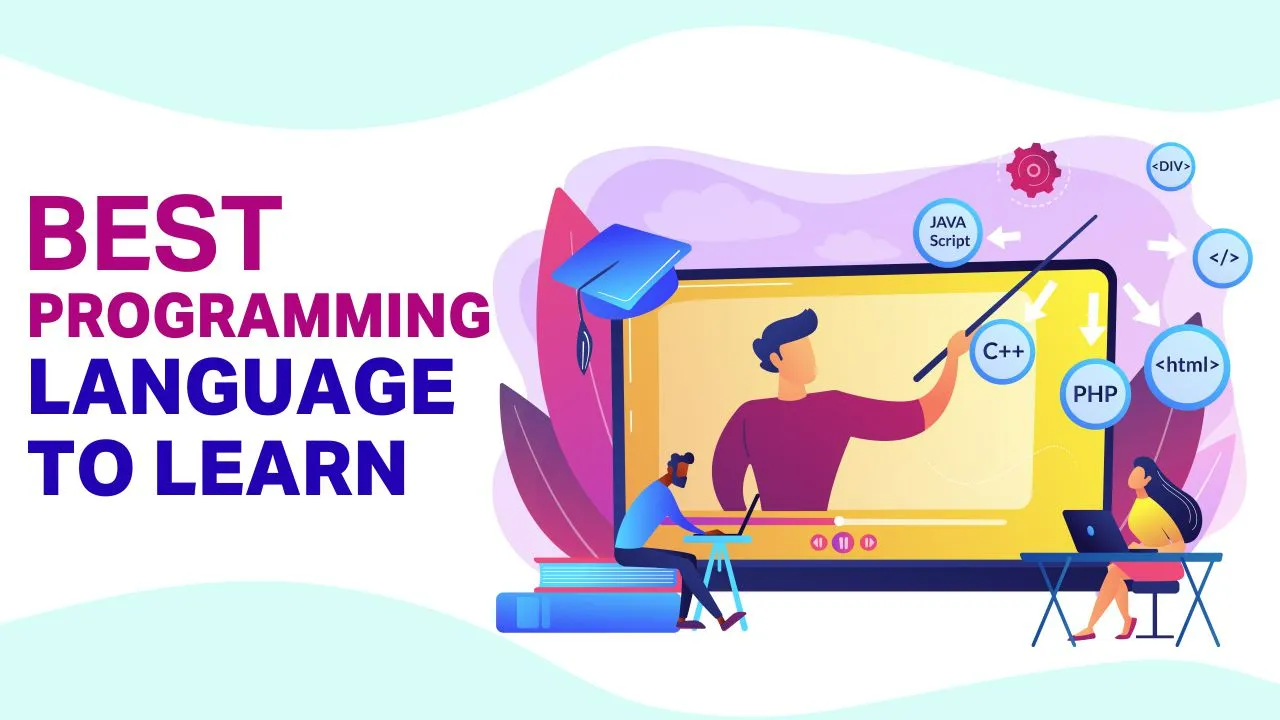
Best Programming Language To Learn In Today’s Time
Best programming languages list 2023: In the bustling landscape of modern technology, where innovation and efficiency reign supreme. The quest to choose the perfect programming language often resembles selecting the most savoury dish from a diverse buffet. With each language boasting its own unique flavours and specialities, it’s a tantalizing challenge to pinpoint the one that suits your palate. From the polished elegance of Python to the lightning-fast prowess of Go, and the versatile charm of JavaScript to the steadfast reliability of Java, the options are as abundant as they are captivating.
In this era of digitized wonders and unlimited possibilities. So to give you a clear picture of all the best types of programming language, we delve into the heart of the matter. So, read this blog that holds the key to unlocking your coding ambitions in this dynamic technological era.
What Is Computer Programming Languages?
Computer programming languages are formal languages designed to communicate instructions to a computer system. These instructions are mainly used to create software, applications, and various functionalities. Some of the programming languages include Python, Java, C++, JavaScript, Ruby, Swift, Go, and more, with each programming language having its own features, strengths, and areas of specialization, making them suitable for various types of software development, ranging from web and mobile applications to system-level programming and data analysis. In simple terms, programming languages provide a way for humans to communicate with computers by writing code in a syntax that the computer can comprehend and execute.
Types Of Programming Languages List 2023
1. Python
Python is a popular high-level programming language best known for its simplicity and readability. It was created by Guido van Rossum and first released in 1991, Python has gained immense popularity in various fields such as web development, prototyping, data analysis, scientific computing, automation and more.
Python’s design philosophy emphasises code readability, which makes it easier for programmers to write clear and concise code. Furthermore, It uses indentation to define code blocks, which helps improve code organization and readability.
Python offers a large standard library that provides modules and functions for a wide range of tasks. Moreover, it allows developers to accomplish complex tasks with relatively minimal code. Additionally, its versatility allows it to be used for various programming paradigms, including procedural, object-oriented, and functional programming.
| Difficulty Level | Easy to Learn and Utilize |
| Necessary Skills | Basic understanding of Programming |
| Average Annual Pay in India | ₹5,80,000 per year |
| Pros |
|
| Cons |
|
2.JavaScript
JavaScript is the most used client-side programming language for creating websites (approximately 98%) according to year 2022 stats. It’s a versatile programming language mainly used for web development. It runs in web browsers, enabling interactive and dynamic features like animations, form validation, and real-time updates on websites.
In Addition, it is utilized for server-side scripting (Node.js) and mobile app development. With its event-driven nature and wide ecosystem of libraries and frameworks, JavaScript is essential for creating engaging user experiences on the web.
| Difficulty Level | Easy to learn due to its forgiving syntax. However, its more advanced concepts, asynchronous programming, and quirks can make it more challenging as you delve deeper. |
| Necessary Skills | Basic understanding of HTML and CSS |
| Average Annual Pay in India | INR 4.2 Lacs |
| Pros |
|
| Cons |
|
3. Java
Java is one of the best programming languages known for its versatile “write once, run anywhere” capability. It’s used in various domains, from web applications to mobile apps (Android). Java offers strong object-oriented features, a robust standard library, and automatic memory management. Its platform independence, thanks to the Java Virtual Machine (JVM), allows code to be executed on different systems without modification.
| Difficulty Level | Moderately difficult to learn for beginners |
| Necessary Skills | Proficiency in Java requires an understanding of object-oriented programming, data structures, algorithms, and software development concepts. |
| Average Annual Pay in India | INR 4 LPA |
| Pros |
|
| Cons |
|
4. C#
C# ( pronounced as “C sharp”) is a versatile, one of the best object-oriented computer programming languages developed by Microsoft. It’s widely used for building various types of applications, including desktop, web, and mobile apps within the .NET framework. With features like strong typing and garbage collection, C# simplifies memory management and provides a robust environment for software development across different platforms.
| Difficulty Level | Moderately challenging to learn |
| Necessary Skills | Good understanding of object-oriented programming, data structures, algorithms, and familiarity with the .NET framework. |
| Average Annual Pay in India | ₹ 3.6 Lakhs |
| Pros |
|
| Cons |
|
5. C++
C++ is a powerful, multi-paradigm programming language renowned for its performance and versatility. It’s an extension of the C language, incorporating object-oriented features and templates. C++ is widely used for systems programming, game development, and high-performance applications. It offers low-level memory control, efficient execution, and a rich standard library.
| Difficulty Level | Hard to learn |
| Necessary Skills | Excellent knowledge of object-oriented programming, memory management, data structures, and algorithms. |
| Average Annual Pay in India | INR 7.9 LPA |
| Pros |
|
| Cons |
|
6. Ruby
Ruby is a dynamic, object-oriented scripted language better known for its simplicity and productivity. It emphasizes elegant code and follows the principle of “developer happiness.” Ruby’s clear syntax and powerful metaprogramming capabilities allow developers to express ideas in a concise and readable manner. It’s commonly used for web development (Ruby on Rails) and offers a supportive community and ecosystem of gems (libraries).
| Difficulty Level | Easy to learn due to its clear and readable syntax. |
| Necessary Skills | Basic knowledge of object-oriented programming, basic programming concepts, and familiarity with the Ruby ecosystem. |
| Average Annual Pay in India | INR 5 LPA |
| Pros |
|
| Cons |
|
7. Swift
Developed by Apple, Swift is a modern, safe, and fast programming language developed by Apple. It’s designed for building applications on various Apple platforms, including iOS, macOS, watchOS, and tvOS. Swift offers a concise syntax, memory safety features, and a robust standard library. Its performance and interoperability with Objective-C make it a popular choice for developing apps within the Apple ecosystem.
| Difficulty Level | Moderately difficult to learn due to its unique features and Apple ecosystem specifics. |
| Necessary Skills | Understanding of object-oriented programming, mobile app development concepts, and familiarity with Apple’s development tools. |
| Average Annual Pay in India | $89,736/year |
| Pros |
|
| Cons |
|
8. Kotlin
Kotlin is a modern, statically typed programming language developed by JetBrains and some other open-source contributors. It’s designed to be concise, expressive, and interoperable with existing Java code. Kotlin is favoured for Android app development due to its enhanced features, null safety, and reduced boilerplate code. Its versatility, clean syntax, and strong tooling make it a popular choice for a wide range of application development.
| Difficulty Level | Normally easy to learn, especially for those with Java experience. |
| Necessary Skills | Familiarity with modern programming practices. |
| Average Annual Pay in India | INR 5.3 Lakhs |
| Pros |
|
| Cons |
|
9. Rust
Rust is a new-age systems programming language focused on factors such as safety, speed, and concurrency. It aims to prevent memory-related errors like null pointer dereferences and data races through a combination of strict compile-time checks and modern language features. Rust’s memory management system and strong guarantees make it ideal for building high-performance, reliable, and secure applications, especially in areas like systems programming, embedded devices, and web servers.
| Difficulty Level | Hard to Learn |
| Necessary Skills | Knowledge of systems programming, memory management, and concurrent programming concepts. |
| Average Annual Pay in India | $89,872/year |
| Pros |
|
| Cons |
|
10. Go (Golang)
Go, often referred to as Golang, is a statically typed, compiled programming language designed by Google. It prioritizes simplicity, efficiency, and performance. Go’s clean syntax, built-in concurrency support, and garbage collection make it suitable for building scalable, concurrent systems. It’s used in various domains, including cloud services, networking, and distributed systems, where performance and developer productivity are crucial.
| Difficulty Level | Easy to Learn and Utilize |
| Necessary Skills | Basic understanding of Programming |
| Average Annual Pay in India | ₹5,80,000 per year |
| Pros |
|
| Cons |
|
Remember that the “best programming language”, depends on what you want to achieve. If you’re interested in web development, then JavaScript, Python, Ruby, and others might be more relevant. Whereas, Swift, Kotlin, and Java could be key for mobile app development. If you’re more interested in system-level programming, then going for upskilling yourself in C++, Rust, and Go might be appealing. Moreover, always research and consider the latest trends, job market demands, and personal interests when choosing a programming language to learn.
Recent Post
